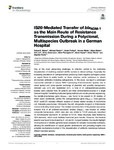IS26-Mediated Transfer of blaNDM–1 as the Main Route of Resistance Transmission During a Polyclonal, Multispecies Outbreak in a German Hospital
Weber, Robert E.
Pietsch, Michael
Frühauf, Andre
Pfeifer, Yvonne
Martin, Maria
Luft, Dirk
Gatermann, Sören
Pfennigwerth, Niels
Kaase, Martin
Werner, Guido
Fuchs, Stephan
One of the most demanding challenges in infection control is the worldwide dissemination of multidrug-resistant (MDR) bacteria in clinical settings. Especially the increasing prevalence of carbapenemase producing Gram-negative pathogens poses an urgent threat to public health, as these enzymes confer resistance to almost all β-lactam antibiotics including carbapenems. In this study, we report a prolonged nosocomial outbreak of various NDM-1-producing Enterobacterales species due to clonal spread and cross-species exchange of plasmids and possibly transposons. Between July 2015 and September 2017, a total of 51 carbapenemase-positive isolates were collected from 38 patients and three environmental sources in a single German hospital. Combining molecular typing methods and whole genome sequencing, the metallo-β-lactamase gene blaNDM–1 was found to be present in 35 isolates of which seven additionally carried the carbapenemase gene blaKPC–2. Core genome MLST (cgMLST) revealed different clusters of closely related isolates of Escherichia coli, Klebsiella pneumoniae, Citrobacter freundii, Morganella morganii or Enterobacter cloacae indicating clonal spread. The detailed reconstruction of the plasmid sequences revealed that in all outbreak-associated isolates blaNDM–1 was located on similar composite transposons, which were also very similar to Tn125 previously described for Acinetobacter baumannii. In contrast to Tn125, these structures were flanked by IS26 elements, which could facilitate horizontal gene transfer. Moreover, the identical plasmid was found to be shared by E. coli and M. morganii isolates. Our results highlight the importance of detailed genome-based analyses for complex nosocomial outbreaks, allowing the identification of causal genetic determinants and providing insights into potential mechanisms involved in the dissemination of antibiotic resistances between different bacterial species.

